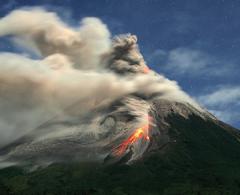
This Article From Issue
January-February 2007
Volume 95, Number 1
Page 5
DOI: 10.1511/2007.63.5
To the Editors:
"Algae-Dominated Reefs" by Peter S. Vroom, Kimberly N. Page, Jean C. Kenyon and Russell E. Brainard (September-October) extols the virtues of "healthy" coral reefs dominated by seaweed but ignores over 150 years of research achievement that began with Charles Darwin's pathbreaking 1842 book Coral Reefs. As Darwin hypothesized, and uncountable drill cores confirmed, coral reefs and atolls are built from growth of corals and coralline algae. The authors are struck by the predominance of macroalgae and lack of corals on what appear to be otherwise healthy reefs from a variety of Pacific reef sites. But fleshy macroalgae are incapable of constructing the very reef structures they now so boldly dominate.
This is a classic example of the "shifting baseline syndrome" whereby our perceptions continually shift to later and later time periods when degradation has already worked its turmoil, and scientists of today are happy to believe that what they are seeing is pristine, no matter what the history, ecology or underlying geological structure might tell them. If corals were always so unimportant in the reefs the authors examined, how did the atolls and coral reefs get there in the first place?
The authors also make the mistake of equating all macroalgae, but many studies have shown that coralline algae are useful in facilitating coral recruitment and growth on reefs, whereas fleshy macroalgae are harmful in the extreme because they are capable of overgrowing corals, of inhibiting their growth and of inducing disease. A more defensible interpretation of the data they represent would have treated the different algal groups separately because of their varied ecosystem functions.
John M. Pandolfi
University of Queensland
Australia
Jeremy B. C. Jackson
Scripps Institution of Oceanography
University of California, San Diego
Smithsonian Tropical Research Institute, Balboa, Republic of Panamá
Drs. Vroom, Page and Kenyon respond:
Drs. Pandolfi and Jackson are confusing "healthy" with "reef accretion." Reef accretion is just one parameter out of many that must be combined to assess reef health. We do not ignore the fact that islands and atolls are built from coral and coralline algae, but rather, as we state in our article, many reefs are in different successional states. For instance, the northwestern Hawaiian Islands, which represent healthy, anthropogenically unimpacted ecosystems dominated by top predators, may have been dominated by corals in past millennia. However, as tectonic plate movements shift these islands farther north, cooler sea-surface temperatures are currently not as conducive to extensive coral growth.
This does not mean these reefs aren't healthy, but merely that they represent a different type of reef than one that might be found right on the equator. This is natural and is what would be expected. Similarly, even reefs situated near the equator possess different geomorphic zones characterized by heterogeneity and differing amounts of coral cover. At many reefs, severe wave motion in fore reef regions hinders coral growth while promoting algal growth. Therefore, dense coral thickets and reef accretion likely occur in more sheltered parts of the ecosystem.
We are confused as to why Drs. Pandolfi and Jackson say we equate all algae. We clearly separated coralline algae, turf algae and macroalgae in the article and discussed how each group is important to the reef ecosystem. We acknowledge that coralline algae are essential for coral recruitment and growth. As scientists, we know that biological organisms play many roles in ecosystems, and to stereotype all macroalgae as harmful without understanding the roles they may play in healthy ecosystems seems shortsighted and scientifically irresponsible.
For instance, Caulerpa taxifolia, a noxious invader that overgrows acres of substrate in the anthropogenically disturbed Mediterranean, is a natural, but minor, component of most tropical Pacific reefs we survey, yet we have never observed it to overgrow living coral in these ecosystems. Instead, it often grows harmoniously with coral, forming small patches on the underside of thriving coral heads and tables, well away from living coral polyps.
If past millennia were not conducive to algal growth in reef systems, then what allowed for the thousands of currently known tropical reef algae to evolve? Because many corals are not suited to harsh water environments, what besides algae would have occurred in fore reef areas in reef ecosystems thousands of years ago?

American Scientist Comments and Discussion
To discuss our articles or comment on them, please share them and tag American Scientist on social media platforms. Here are links to our profiles on Twitter, Facebook, and LinkedIn.
If we re-share your post, we will moderate comments/discussion following our comments policy.